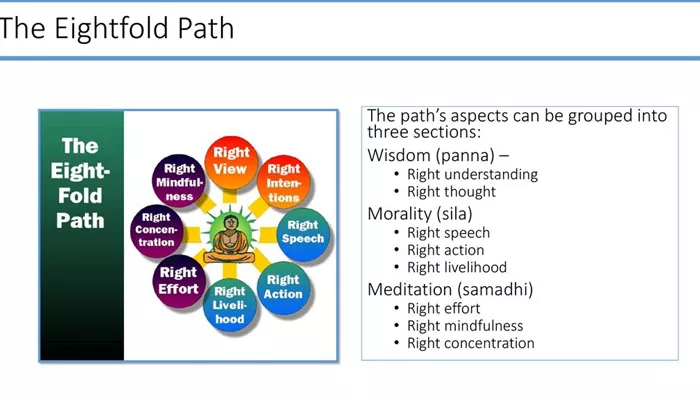The Four Noble Truths and the Eightfold Path are the heart of Buddhist teaching. They guide millions of people on how to understand suffering and how to find peace. But who first taught these important lessons? This article explains in simple words the origin of these teachings and their deep meaning.
The Origin of Buddhism and Its Founder
Buddhism started over 2,500 years ago in India. The founder was a man named Siddhartha Gautama. He is also called the Buddha, which means “The Awakened One.” Before becoming the Buddha, Siddhartha was a prince who lived a very sheltered life. He did not know much about suffering.
How Siddhartha Gautama Became the Buddha
One day, Siddhartha left his palace and saw old age, sickness, and death for the first time. These sights made him realize that suffering is part of life. He decided to find a way to end suffering. Siddhartha left his royal life and practiced deep meditation and searching for truth for many years.
The Moment of Enlightenment
After a long time of meditation under the Bodhi tree, Siddhartha gained deep understanding. He realized the nature of suffering and how to overcome it. This moment is called his enlightenment. From then on, he was known as the Buddha.
Who First Taught the Four Noble Truths?
After his enlightenment, the Buddha wanted to share his discovery. The very first teaching he gave is called the First Turning of the Wheel of Dharma. In this teaching, he explained the Four Noble Truths.
What Are the Four Noble Truths?
- The Truth of Suffering (Dukkha): Life includes pain and suffering.
- The Truth of the Cause of Suffering (Samudaya): Suffering comes from desire and attachment.
- The Truth of the End of Suffering (Nirodha): It is possible to end suffering.
- The Truth of the Path Leading to the End of Suffering (Magga): Following a certain path can end suffering.
These truths form the foundation of Buddhist thought. They explain why people suffer and how they can find peace.
Who First Taught the Eightfold Path?
The fourth noble truth tells us there is a path to end suffering. This path is called the Eightfold Path. The Buddha was the first to teach this path clearly.
What Is the Eightfold Path?
The Eightfold Path is a guide to live wisely and ethically. It has eight parts that help a person develop the mind and behavior.
- Right View: Understand the Four Noble Truths.
- Right Intention: Have the right thoughts and aims.
- Right Speech: Speak truthfully and kindly.
- Right Action: Behave in a good and moral way.
- Right Livelihood: Choose a job that does not harm others.
- Right Effort: Work hard to improve oneself.
- Right Mindfulness: Be aware of the present moment.
- Right Concentration: Practice deep meditation.
The Importance of the Eightfold Path
The Buddha taught the Eightfold Path as a practical way to end suffering. By following it, a person can develop wisdom, ethical conduct, and mental discipline. Together, these lead to enlightenment and freedom from suffering.
The Historical Context of These Teachings
The Buddha lived in a time when many religious ideas existed in India. His teachings were different because they focused on practical steps to end suffering, not just rituals or gods. His followers spread these teachings through India and beyond.
The First Followers of the Buddha
After his first sermon, five monks who had been his companions became his first disciples. They understood his message and helped spread it. Over time, many people joined the Buddhist community, called the Sangha.
The Symbolism of the Eightfold Path
The eightfold path symbol is often shown as a wheel with eight spokes. This wheel, called the Dharmachakra, represents the cycle of teaching and the path to enlightenment. Each spoke stands for one part of the path, showing that all parts are connected and important.
The Eightfold Path as a Religion and Practice
The eightfold path religion is not a religion in the usual sense. It is a way of life and a practice to help people live better and find peace. Buddhism uses these teachings as a guide rather than strict rules.
How People Practice the Eightfold Path Today
Many people around the world follow the Eightfold Path. They try to live with kindness, mindfulness, and wisdom. Meditation is a key part of the practice, helping to develop concentration and awareness.
The Impact of the Four Noble Truths and Eightfold Path
The Buddha’s teachings have influenced millions over more than two thousand years. They have helped people understand suffering, live ethically, and seek spiritual freedom. Today, these teachings are studied and practiced globally in many cultures.
Modern Relevance
The ideas in the Four Noble Truths and Eightfold Path are still very relevant. People use them to reduce stress, improve mental health, and find meaning in life. The simplicity and depth of the teachings make them timeless.
Conclusion
The Four Noble Truths and the Eightfold Path were first taught by Siddhartha Gautama, the Buddha. After his enlightenment, he shared these teachings to help others end suffering. These teachings remain the foundation of Buddhism and continue to inspire people worldwide.

